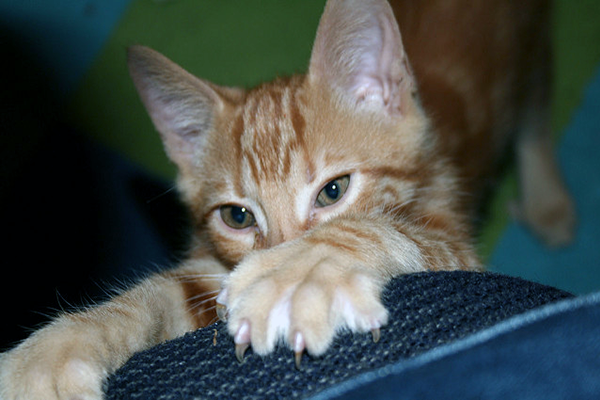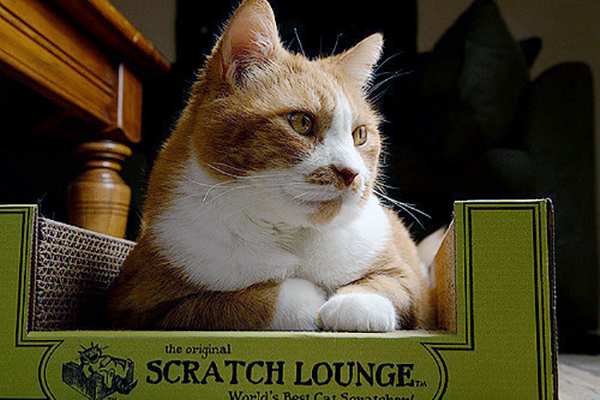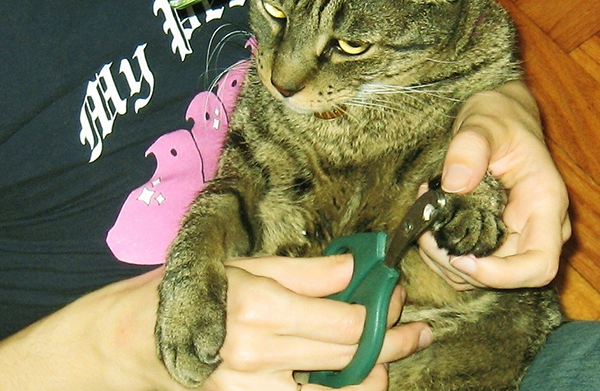I’ve always been a staunch opponent of declawing cats. In fact, when I filled out the application to adopt my sweet, departed Dahlia, I answered the question “Do you intend to declaw this cat?” with “Hell no!!!” I even have an anti-declawing bumper sticker on the back of my car.

The only trouble is, I’ve had some people mistake it for a pro-declawing sticker, and I’ve had some interesting (and ultimately very rewarding) conversations with other anti-declawing people who at first misinterpreted my sticker as support for what I — and a growing number of veterinarians — view as a cruel and inhumane practice.
Of course, it is tremendously frustrating if you have a cat scratching furniture, carpets and your favorite clothes, but there are plenty of other alternatives to amputating the ends of all your cat’s toes. Here are a few simple things you can do to prevent unwanted scratching and avoid a major surgery with potential major consequences.

1. Make the objects of inappropriate scratching unattractive
There are plenty of things that annoy cats enough to potentially deter them from scratching on furniture and carpets. Some people swear by putting aluminum foil on furniture to keep cats from scratching because the texture supposedly makes cats reluctant to scratch. Other options include double-sided tape or Sticky Paws, or adding unpleasant fragrances such as citrus, or using motion-activated air sprayers.
2. Get some good scratching surfaces
Scratching is a natural behavior; it serves to mark territory and to help a cat get a good stretch, so you need to provide an alternative. As celebrity cat behaviorist Jackson Galaxy says, “For every no, provide a yes.” That “yes” should come in the form of an appropriate scratching surface, which you’ll want to place next to the “no” surface. Some cats prefer to scratch horizontal surfaces and some prefer to scratch vertically. Some cats even like both.

The trouble is that a lot of scratching posts you see in stores are short and covered in carpet and don’t really meet your cat’s needs for a good stretch and scratch. What your cat needs is a tall, sisal-covered post with a heavy base so it won’t tip over when your cat tries to scratch. For horizontal scratching, cardboard scratching pads are easily available and not too expensive.
3. Provide distractions to prevent cat scratching
If you see your cat getting ready to scratch something you don’t want him to scratch, get out a toy and start playing with him. Most cats will find a rousing game of Catch The Mousie a lot more attractive than scratching the back of your sofa. The key to this is to provide the distraction before your cat starts scratching; otherwise, you might end up reinforcing the unwanted behavior by making him think that scratching is what causes the interactive toy to come out.

4. Trim your cat’s nails
I know, I know: You’re probably thinking “What a joke!” But it’s really not as hard as you might think, as long as you have patience and the right equipment. I personally prefer the little scissor-type claw trimmers because they’re quiet and sharp and they get the job done well. And yes, patience is key, especially if you haven’t trimmed your cat’s claws before.
Here’s a great video about how to trim your cat’s claws:
My cat, Dahlia, hated having her claws trimmed, so I used the “sneak and snip” method: I would catch her when she was really relaxed, just waking up from a nap, and trim a couple of claws before she fully realized what was going on.

5. Use vinyl nail caps
If you want to keep your cat from scratching your furniture, invest in some Soft Paws and place them on your cat’s claws. You will have to re-apply them regularly because as the claws continue to grow, the outer layers get shed to make room, and with those outer layers will go the nail caps.
What have you done to keep your cat from scratching? How has it worked for you? Do you have any other tips? Please share them in the comments!
Read more about cat claws and cat scratching on Catster.com:








